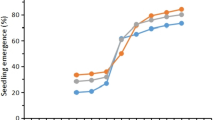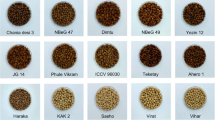Abstract
The increased interest in chickpea cultivation is related to consumers’ demand for organic food. Therefore, the proximate composition, seed weight (SW), total phenolic content (TPC), phenolic acids, flavonoids, total carotenoid content (TCC), and antioxidant activity (AA) of ten colored chickpea cultivars (one black desi cultivar and nine cream kabuli cultivars) were studied. Data were analyzed by ANOVA and means separated by Tuckey’s test. The cultivars were grown in organic farming in comparison to conventional farming of the Italian Council for Agricultural Research and Economics, Research Centre for Cereal and Industrial Crops of Foggia (southern Italy), in a complete randomized block design with three replicates during 2013–2014 crop season. The study demonstrated that the composition of chickpeas may be modulated by the farming system. The organic farming positively affected SW, protein content (PC), TCC, and AA indicating a good commercial quality of the crop. The AA was significantly higher in organic farming of about 6.5%. But the TPC, phenolic acids, and flavonoids were lesser than conventional farming. In organic farming, genistein and daidzein levels were significantly lower, while α-Tocopherol (α-T) and TCC were higher in conventional farming. These findings suggest their involvement in plant defense mechanism from abiotic and biotic stress. The PCA (principal component analysis) showed that the chickpea cultivars were well separated based on the prevalence of α-tocopherol in the kabuli cultivars while rutin, kaempferol 3-O-rutinoside, and kaempferol 3-O-rhamnoside were prevalent in the desi cultivar. In organic farming, the increase of content of α-T was observed solely in kabuli cultivars, while in desi cultivar, the increase was found for ferulic acid and AA.

Similar content being viewed by others
References
Aguilera Y, Duenas M, Estrela I, Hernandez T, Benitez V, Esteban RM, Martin-Cabrejas AA (2011) Phenolic profile and antioxidant capacity of chickpeas as affected by dehydration process. Plant Foods Hum Nutr 66:187–195
Amarowicz R, Pegg RB (2008) Legumes as a source of natural antioxidants. Eur J Lipid Sci Tech 110:865–878
American Association of Cereal Chemists (AACC) (2012) Approved methods of AACC (11th edn.) Methods 46–30.01 (protein), St Paul, MN
Aslam M, Mahmood I A, Herridge DF (2000) Contribution of chickpea fixed N2 in increasing rain - fed wheat production in Potohar, Pakistan. Soil Sci Soc Pak, p 26
Balisteiro DM, Rombaldi CV, Genovese MI (2013) Protein, isoflavones, trypsin inhibitory and in vitro antioxidant capacities: comparison among conventionally and organically grown soybeans. Food Res Int 51:8–14
Bazzano LA, Tees CH, Nguyen MT (2008) Effect of non-soy legume consumption on cholesterol levels: a meta-analysis of randomized controlled trials. Circulation 118:1122
Beleggia R, Platani C, Nigro F, Cattivelli L (2010) A micro-method for the determination of yellow pigment content in durum wheat. J Cereal Sci 52:106–110
Beta T, Nam S, Dexter JE, Sapirstein HD (2005) Phenolic content and antioxidant activity of pearled wheat and roller-milled fractions. Cereal Chem 82:390–393
Boschin G, Arnoldi A (2011) Legumes are valuable sources of tocopherols. Food Chem 127:1199–1203
Bramley PM, Elmadfa I, Kafatos A, Kelly FJ, Manios Y, Roxborough HE, Schuch W, Sheehy PJA, Wagner KH (2000) Vitamin E. J Sci Food Agric 80:913–938
Brandt K, Mølgaard JP (2001) Organic agriculture: does it enhance or reduce the nutritional value of plant foods? J Sci Food Agric 81:924–931
Campos-Vega R, Reynoso-Camacho R, Pedraza-Aboytes RG, Acosta-Gallegos JA, Guzman- Maldonado SH, Paredes-Lopez O, Oomah BD, Loarca-Piña G (2009) Chemical composition and in vitro polysaccharide fermentation of different beans (Phaseolus vulgaris L.). J Food Sci 74:59–65
De Santis MA, Rinaldi M, Menga V, Codianni P, Giuzio L, Fares C, Flagella Z (2021) Influence of organic and conventional farming on grain yield and protein composition of chickpea genotypes. Agronomy 191(11):1–15. https://doi.org/10.3390/agronomy11020191
Del Amor FM, Serrano-Martinez A, Fortea I, Nunez Delicado E (2008) Differential effect of organic cultivation on the levels of phenolics, peroxidase and capsidiol in sweet peppers. J Sci Food Agric 88:770–777
Dragsted LO (2003) Antioxidant action of polyphenols in human. Int J Vitamin Nutr Res 73:112–120
Eberhardt MV, Lee CY, Liu RH (2000) Antioxidant activity of fresh apples. Nature 405:903–904
Englyst K, Vinoy S, Englyst HN, Lang V (2003) Glycaemic index of cereal products explained by their content of rapidly and slowly available glucose. Br J Nutr 89:329–340
Faller ALK, Fialho E (2010) Polyphenol content and antioxidant capacity in organic and conventional plant food. J Food Compos Anal 23:561–568
Fares C, Menga V (2012) Effects of toasting on the carbohydrate profile and antioxidant properties of chickpea (Cicer arietinum L.) flour added to durum wheat pasta. Food Chem 131:1140–1148
Fares C, Platani C, Baiano A, Menga V (2010) Effect of processing and cooking on phenolic acid profile and antioxidant capacity of durum wheat pasta enriched with debranning fractions of wheat. Food Chem 119:1023–1029
Fares C, Menga V, Codianni P, Russo M, Perrone D, Suriano S, Savino M, Rascio A (2019) Phenolic acids variability and grain quality of organically and conventionally fertilised old wheats under a warm climate. J Sci Food Agric 99:4615–4623
Guidelines of the Common Agriculture Policy 2014–2020 (CAP). https://ec.europa.eu/info/food-farming-fisheries/key-policies/common-agricultural-policy/cap-glance_en. Accessed May 2019
Gül MK, Egesel CÖ, Turkam H (2008) The effects of planting time on fatty acids and tocopherols in chickpea. Eur Food Res Technol 222:517–522
IFOAM & FiBL-Organics International (2020) The world of organic agriculture. statistic and emerging trends 2020. www.fibl.org/en/shop-en/5011-organic-world-2020.html
Lozovaya VV, Lygin AV, Zernova OV, Ulanov AV, Li S, Hartman GL, Widholm JM (2007) Modification of phenolic metabolism in soybean hair roots through down regulation of chalcone synthase or isoflavone synthase. Planta 225:665–679
Lygin AV, Hill CB, Zernova OV, Crull L, Widholm JM, Hartman GL, Lozovaya VV (2010) Response of soybean pathogens to glyceollin. Phytopathology 100:897–903
Magalhães S, Taveira M, Cabrita A, Fonseca A, Valentão P, Andrade P (2017) European marketable grain legume seeds: further insight into phenolic compound profiles. Food Chem 215:177–184
Marathe SA, Rajalakshmi V, Jamdar SN, Sharma A (2011) Comparative study on antioxidant activity of different varieties of commonly consumed legumes in India. Food Chem Toxicol 49:2005–2012
Mozafar A (1993) Nitrogen fertilizers and the amount of vitamins in plants reduce the abiotic stress A Review. J Plant Nutr 16:2479–2506
Prosky L, Asp NG, Schweizer TF, De Vries JW, Furda I (1992) Determination of insoluble and soluble dietary fiber in foods and food products: collaborative study. J AOAC 75:360–367
Re R, Pellegrini N, Proteggente A, Pannala A, Yang M, Rice-Evans C (1999) Antioxidant activity applying an decolorization assay improved ABTS radical cation. Free Radic Biol Med 98:1231–1237
Segev A, Badani H, Kapulnik Y, Shomer I, Oren-Shamir M, Galili S (2010) Determination of polyphenols, flavonoids, and antioxidant capacity in colored chickpea (Cicer arietinum L). J Food Sci 75:S115–S119
Singleton VL, Rossi JA (1965) Colorimetry of total phenolics with phosphomolybdic–phosphotungstic acid reagents. Am J Enol Viticult 16:144–158
Tsochatzis ED, Bladenopoulos K, Papageorgiou M (2012) Determination of tocopherol and tocotrienol content of Greek barley varieties under conventional and organic cultivation techniques using validated reverse phase high-performance liquid chromatography method. J Sci Food Agric 92:1732–1739
Wang N, Hatcher DW, Tyler RT, Toews R, Gawalko EJ (2010) Effect of cooking on the composition of beans (Phaseolus vulgaris L.) and chickpea (Cicer arietinum L.). Food Res Int 43:589–594
Wood JA, Knights EJ, Choct M (2011) Morphology of chickpea seeds (Cicer arietinum L.): comparison of desi and kabuli types. Int J Plant Sci 172:632–643
Zielińska D, Turemko M, Kwiatkowski J, Zieliński H (2012) Evaluation of flavonoid contents and antioxidant capacity of the aerial parts of common and tartary buckwheat plants. Molecules 17:9668–9682
Author information
Authors and Affiliations
Corresponding author
Ethics declarations
Conflict of interest
The authors declare no competing interests.
Additional information
Publisher’s note
Springer Nature remains neutral with regard to jurisdictional claims in published maps and institutional affiliations.
Supplementary Information
Below is the link to the electronic supplementary material.
13165_2021_365_MOESM1_ESM.docx
Supplementary file1 Supplementary Figure 1: active nodules in organically and conventionally cultivated chickpeas. Means with different letters are significantly different at 0.05 probability level (Tukey’s Test) (DOCX 20 KB)
Rights and permissions
About this article
Cite this article
Fares, C., Suriano, S., Codianni, P. et al. Phytochemical profile of chickpea cultivars grown in conventional and organic farms in Southern, Italy. Org. Agr. 11, 589–600 (2021). https://doi.org/10.1007/s13165-021-00365-z
Received:
Accepted:
Published:
Issue Date:
DOI: https://doi.org/10.1007/s13165-021-00365-z




